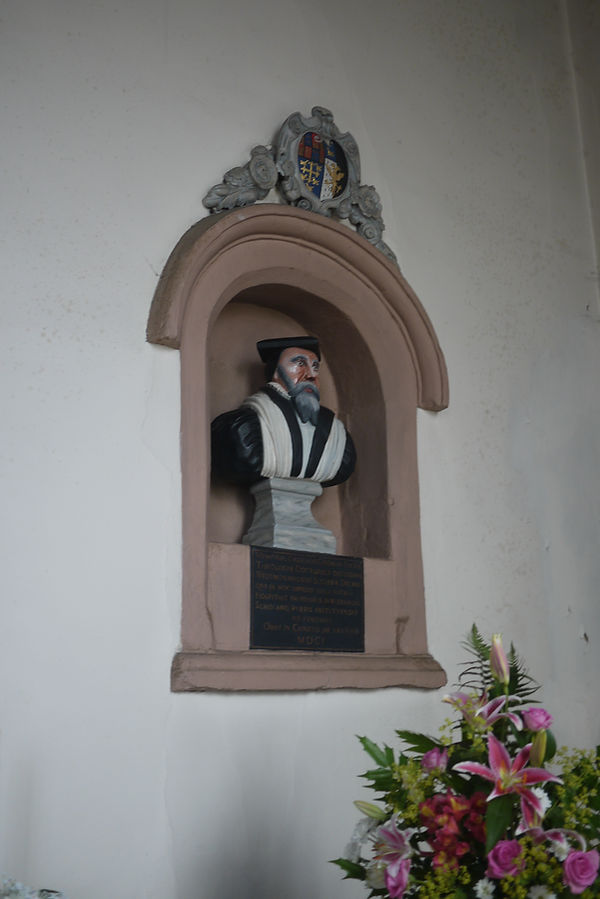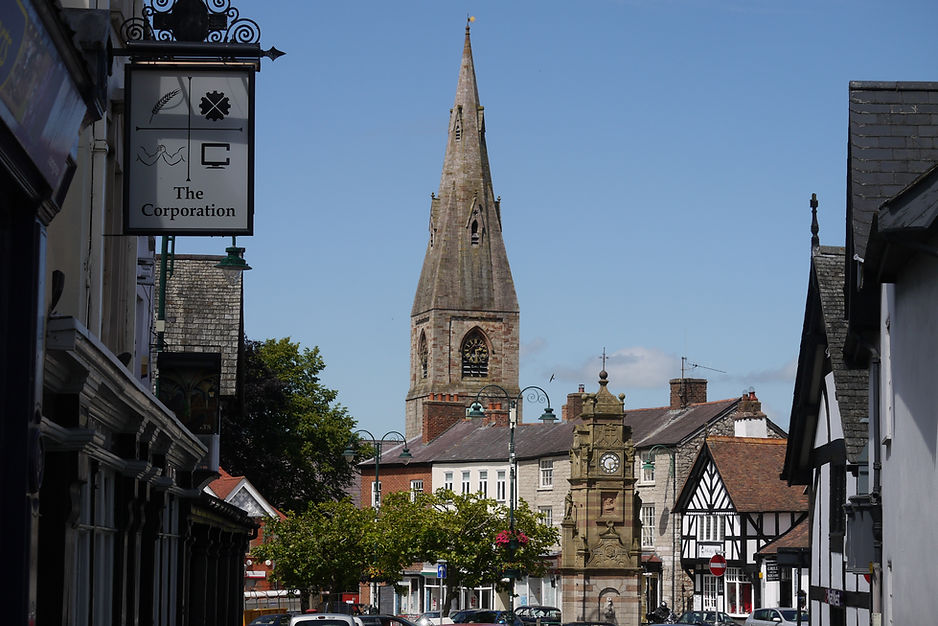
Evidence of the historical importance and influence of Ruthin can be found in the presence of one of the most impressive churches in the Vale of Clwyd – The Collegiate and Parochial Church of St Peter’s. A chapel dedicated to St Peter was founded in 1286, soon after the Edwardian conquest of the area and the awarding of the cantref of Dyffryn Clwyd to Reginald de Grey, with the intention of creating an English enclave within the area.
At the time of its creation, St Peter’s was under the auspices of St Meugan’s at Llanrhudd, but John de Grey, son of Reginald successfully petitioned for St Peter’s to become a collegiate church in 1310, capella St Petri, to minister to the new borough. Essentially, a college is a community of priests, and at Ruthin this community numbered seven. This might well have been an intentional break from a Celtic past, since St Meugan, to whom the church at Llanrhudd is dedicated was a pre-Conquest, pre-English saint. Being a collegiate church resulted in St Peter’s being administered by a gardiani – a warden, a post that has continued to the present day, and holding equal status with the Lordship of Ruthin. Locally the Church became known as, ‘the Priory’, a name which goes someway to underline the influence it owned in the area.
The church certainly did well out of Ruthin, increasing its landholdings substantially, gifted properties throughout the borough. These gifts were often bequeathed to the Church in the wills of the deceased, in the expectation of prayers and masses. A tithe barn had been built to the north east of the Church, close to what became known as the Prior’s Garden, to store the goods it gained. The 14th century was one of growth and prosperity for St Peter’s. The whole Church was renovated in the Perpendicular Style during this period, becoming a huge double-naved affair, a style distinctive to North East Wales.
However, the 15th century was very different, and started badly. How much damage St Peter’s actually suffered in the uprising of Owain Glyndwr is unknown. Ruthin was the heartland of the de Grey’s, and Glyndwr’s grievances were focused on the Lord of Ruthin. The town was his first target in 1400, and he raided it again in 1402, and although it is believed the damage to the town was extensive, the archaeological evidence is somewhat lacking, and St Peter’s does seem to have got off lightly. What is certain, however, is that the 15th century was a difficult time for the church, and it would seem to have been taken over at some point by the Bonhommes, the Brothers of Penitence, otherwise known as the Bluefriars. This mysterious foundation based on the rule of St Augustine did not own a sizeable presence in Britain, and its history in Ruthin is virtually entirely unknown. However, it went the way of all the other orders with the Reformation of the 16th century. The Lordship of Dyffryn Clwyd was effectively sold to the Crown at the beginning of the 16th century, and it is known that there was something of a power struggle between the de Grey’s and the Crown at the end of the 15th century for control of the Church, with Henry VII gifting the elaborate and wholly impressive wooden ceiling, with its elaborate designs of flowers, badges and much more. Predictably then, the Crown won.

The roof is believed to have been removed from Basingwerk Abbey at is dissolution in 1536. In the 14th century, Robin Ddu, Robin the Dark, a famous welsh seer, correctly prophesied the roof of Abbey would one day grace a church beneath Moel Famu. The prophecy has also been attributed to the roof of St Mary's at Cilcain.
The difficult years of the 16th century, in which the Church suffered through the Reformation along with many others, led to St Peter’s suffering some neglect, the collegiate Church being dispersed in 1535. It was recognised however that St Peter’s fulfilled an important parish responsibility, and this helped alleviate some of the deprivations. However, it was with the return of Gabriel Goodman at the end of the 16th century that St Peters, and indeed Ruthin in general began to emerge from this difficult time.
Goodman was a native of Ruthin that had, if you will pardon the pun, made good. He had become Dean of Westminster and had become very influential in London. He returned to Ruthin in 1574, and refounded Ruthin School, which was not simply an establishment for the rich and the would be clergy, but one which the poor were able to attend. It is believed that 4d was the price of admission to the school, a one off payment for an education, and that the school given accepted a, ‘cheese per quarter’ from some who wanted their children to attend. In 1589, Goodman bought the site of the former college pretty much lock, stock and barrel, recreating the wardenship, in connection with a hospital and even had almshouses built for 12 of the parish poor, 10 men and 2 women. Having returned Ruthin to the stature it had previously enjoyed, he presented the lands and incomes of the churches of Ruthin and Llanrhudd to the diocese of Bangor. By the time of his death in 1601, it can be said that Goodman almost single-handedly reinvented Ruthin, establishing the town as the centre of ecclesiastical and educational influence in North East Wales. His reputation within Ruthin remains high.

Memorial bust of Gabriel Goodman (1561-1601), native of Ruthin, Dean of Westminster Cathedral and re-founder of Ruthin School
However, despite the new Great Bell being cast and established at St Peter’s (paid for jointly by the Myddletons’ and the Salesbury’s, perhaps the two most influential families in the Vale of Clwyd), it would seem the fabric of St Peter’s declined considerably. The old chancel had to be demolished in 1663, and by 1714 it was clear from the records that urgent repairs had to be undertaken. Some, though not all of those repairs were made, it seems, since a further letter of 1754 would suggest that by attending St Peter’s one was risking death or injury, so ruinous had the church become. Curious then that while the church was becoming ever more ruinous, in 1720 the Myddleton’s paid the Davies Brothers of Croes Foel Forge at Bersham in Wrexham to create a set of wrought iron gates for St Peters. The Davies Brothers had become justly famous for their genius in iron, also creating the gates for St Giles Church Church in Wrexham, Leeswood Hall and of course, Chirk Castle, owned by the Myddleton’s.
One of the most notable wardens of St Peters, was the Reverend Richard Newcombe, a notable friend of the Ladies of Llangollen. Taking the position in 1804, he remained in the post for 47 years, undertaking a magisterial biography of Gabriel Goodman. His successor, Bulkeley Owen Jones held the position for even longer, and supervised the massive renovations of St Peter’s, including the building of a spire, the only one in the Vale of Clwyd, essentially creating the Church that we see today.
The interior is striking. Other than the already mentioned nave roof, it is the sheer size of St Peters which is most impressive. The double-naved elegance, essentially two rectangles divided by a row of pillars, is beautiful. There are a number of memorials, including two rare monumental brasses, of the wealthy cloth merchant Edward Goodman, in his mayoral robes, and in a second with his wife and children. One of those children, Gabriel Goodman was discussed earlier, and it is no surprise to find him remembered at St Peters with painted bust near the altar.

The Davies Brothers gates, paid for by the Myddletons, who knew something of the excellence their workmanship.
The exterior of the Church has the look of a small cathedral, another indication of its historical influence. The twelve almshouses were created under the orders of Gabriel Goodman in 1590, to look after the poor of the parish. Ten men and two women, aged over fifty and unmarried were cared for there. They became known as the, ‘Goodman Pensioners’. The old cloisters formed part of the collegiate church of 1310, the Warden living there at least until the new cloisters were built in 1954. St Peter’s has a reputation for music and a 16th century addition to the Old Cloister is now used by the Choirmaster.
St Peters remains proof of the influence of Ruthin in North East Wales, and in Gabriel Goodman, its greatest benefactor, the difference an individual can make to their community.

St Peter's with its spire, rare in Denbighshire, dominates the town.

